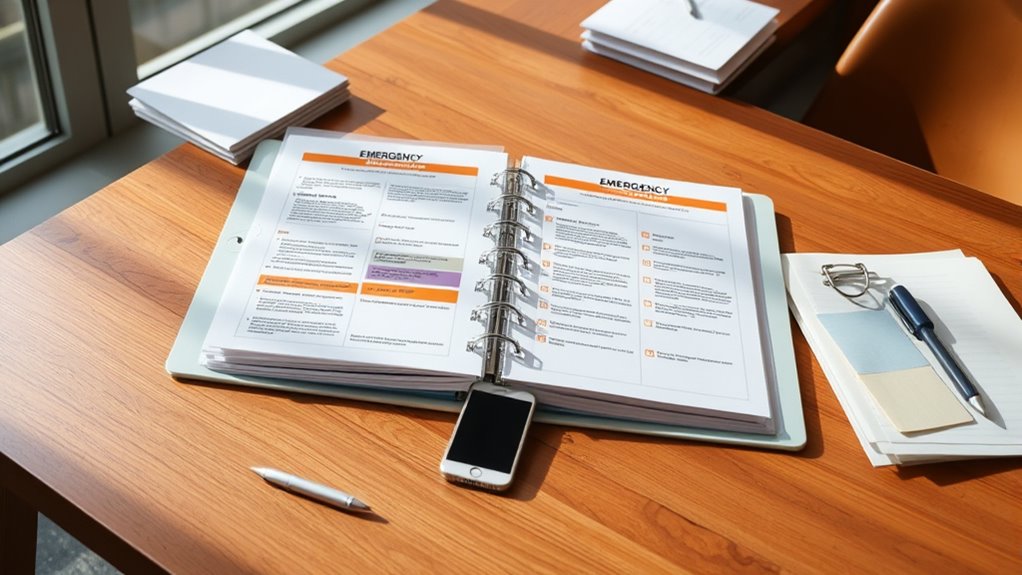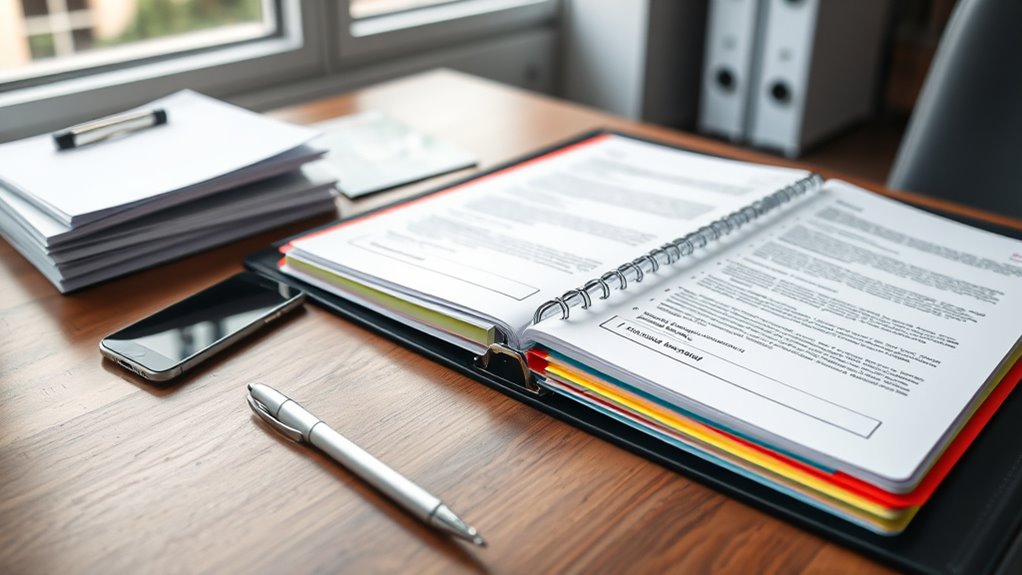Creating an emergency binder for your financial and legal documents is a vital step to stay prepared for unexpected events. Start by organizing important papers like birth certificates, Social Security cards, insurance policies, and legal documents into clearly labeled sections. Keep digital copies secure online or on encrypted drives, and store the physical binder in a fireproof, waterproof, and accessible location. Ensuring both safety and quick access will give you peace of mind—learn more to build an effective system tailored to your needs.
Key Takeaways
- Gather and organize all essential financial and legal documents, labeling sections clearly for quick access.
- Digitally scan documents and store securely online or on encrypted drives for backup and remote access.
- Use fireproof, waterproof containers and keep the binder in a safe, accessible location known to trusted contacts.
- Regularly update the binder to reflect recent changes in accounts, legal documents, or personal information.
- Inform trusted individuals of the binder’s location and ensure they understand how to access and use it in emergencies.

Have you ever thought about how prepared you are in case of an emergency? It’s a question that often gets overlooked until a crisis hits, but taking a proactive approach can make all the difference. Creating an emergency binder for your financial and legal documents is a smart step toward ensuring your important information is accessible and secure when you need it most. One of the first things to consider is digital organization. While physical copies are essential, having digital versions of key documents can notably enhance your document safety. By scanning and storing these files securely online or on encrypted drives, you reduce the risk of losing critical information due to theft, fire, or other disasters. Digital organization allows you to access your documents from anywhere, whether you’re at home or on the go, giving you peace of mind that your important information is always within reach. Ensuring your digital files are stored with encryption and multi-factor authentication further enhances their security against cyber threats.
To maximize document safety, you should invest in a secure storage method for your physical binder. Use a fireproof and waterproof container to protect your legal and financial papers from environmental damage. Keep the binder in a safe, easily accessible location, such as a locked cabinet or a designated safe spot in your home. Make sure that trusted family members or key contacts know where to find it, so they can assist in emergencies. When assembling your binder, include essential documents like birth certificates, Social Security cards, insurance policies, bank account information, wills, and power of attorney papers. Organize these items in clearly labeled sections so you can quickly locate what you need during stressful situations.
Beyond physical organization, it’s indispensable to keep digital backups of everything. Store scanned copies on a secure cloud platform with strong encryption and multi-factor authentication. Regularly update both your physical and digital files to reflect any changes, such as new bank accounts or updated legal directives. Remember, the goal is to make your emergency binder comprehensive, easy to navigate, and resilient against various threats. This preparation not only saves you time during an emergency but also reduces the emotional toll of searching for critical documents amid chaos. By combining physical safeguards with digital organization, you create a robust system that prioritizes document safety. Being organized and prepared means you can face unexpected events with confidence, knowing your financial and legal information is protected and readily available when you need it most.
Frequently Asked Questions
How Often Should I Update My Emergency Binder?
You should review and update your emergency binder at least once a year to guarantee document accuracy and completeness. During your document review, check for any changes in legal or financial info, and update your binder accordingly. Keep it accessible, so you can quickly find what you need in an emergency. Regular updates help guarantee your binder remains a reliable resource when you need it most.
What Security Measures Protect My Sensitive Information?
You should protect your sensitive information with strong encryption methods and strict access controls. Use encrypted digital storage for your emergency binder, ensuring only trusted individuals have access. Password-protect digital files and consider two-factor authentication for added security. Store physical copies in a secure, locked location. Regularly update access permissions and encryption methods to stay ahead of potential threats, keeping your financial and legal documents safe from unauthorized access.
Can Digital Copies Replace Physical Documents in the Binder?
Sure, digital copies can replace physical documents—if you’re comfortable trusting cloud storage and digital backups. Irony strikes: in emergencies, you might find yourself wishing you had those paper originals handy, especially if tech fails or power’s out. While digital backups are convenient, they shouldn’t fully replace your physical documents in the emergency binder. Keep both for peace of mind—you never know when tech might let you down.
How Do I Organize Documents for Multiple Family Members?
You should create separate sections within your binder for each family member to guarantee clear family member organization. Use document categorization to organize essential papers like IDs, insurance, banking info, and medical records for each person. Label each section clearly, and keep a master list of documents for quick reference. Regularly update and review these sections so you’re always prepared for emergencies involving any family member.
What Should I Do if I Lose My Emergency Binder?
If you lose your emergency binder, don’t panic—your life won’t fall apart! Quickly access your digital backups stored securely online, containing all your crucial documents. Call your emergency contacts immediately to inform them and gather essential information. Consider having a duplicate binder in a safe, separate location. Act fast, stay calm, and remember that keeping digital backups and updated emergency contacts can save the day when disaster strikes.
Conclusion
Now that you’ve started your emergency binder, imagine the peace of mind you’ll have when disaster strikes—knowing your essential documents are safe and accessible. But what if something unexpected happens before you’re fully prepared? Don’t wait any longer. Take action now to complete your binder. The sooner you do, the more confident you’ll feel when life throws its worst at you. Are you ready to secure your future today?









